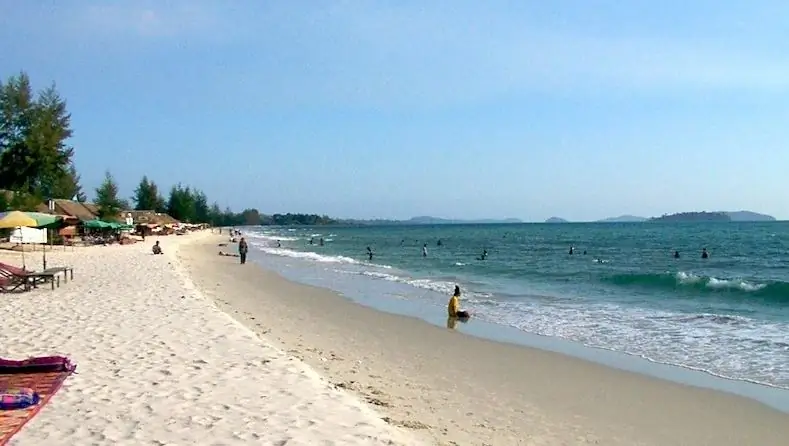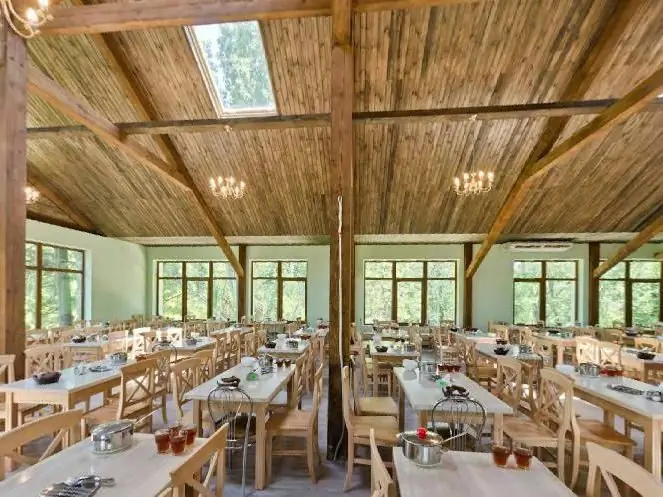- Author Harold Hamphrey [email protected].
- Public 2023-12-17 10:06.
- Last modified 2025-01-24 11:10.
With the onset of summer, the issue of travel and travel is becoming more and more relevant. Where to go this year? What to do with yourself and your loved ones?
After weighing all the pros and cons, you finally come to the conclusion that maybe you shouldn’t spend far from extra money on an expensive foreign tour, because there are so many interesting and unknown.

For example, why not visit the Berezinsky Biosphere Reserve? Guaranteed that most of your friends, buddies and acquaintances have not even heard of the existence of such a place.
But in vain… After all, it is here, not very far from home, that you can get not only a lot of positive emotions, but also valuable knowledge about the peculiarities of your native land.
In this article we will talk not only about the Berezinsky Biosphere Reserve itself. The reader will get acquainted with its history, goals and objectives, and, of course, learn more about the flora and fauna of the reserve.
Section 1. General description of the object

The Berezinsky nature reserve in Belarus was founded on January 30, 1925. Today, its territory covers the Borisovsky district of the Minsk region, as well as the Lepel and Dokshitsky districts of the Vitebsk region.
The area of this place is quite impressive and is 851.5 km2. The natural park is known all over the world as a standard of natural, untouched nature, and partly it makes the rest in Belarus unforgettable.
It should be noted that this natural complex can be considered the most unique, and 60% of its area is a variety of wetlands.
Also, the Berezinsky biosphere reserve (Vitebsk region) is known for its lakes of various origins and sizes. The value of this natural corner lies in the diversity of terrestrial and aquatic ecosystems, as well as in a high degree of their natural preservation.
Section 2. Climatic features

As in the whole of the republic, the weather conditions here are moderate and, one might say, even transitional, i.e. the climate is gradually changing from maritime to continental.
It has warm, humid summers and moderately cold winters with unstable snow cover.
On average, the amount of precipitation per year is 676.6 mm. Throughout the year, the Berezinsky Biosphere Reserve maintains high relative humidity ranging from 80 to 89%.
For mid-late November, permanent snow cover is already inherent. But in some years it is still characterized by low power and inconstancy, and sometimesmay be absent for half or even the entire winter.
Section 3. How did such a unique place come about?

Approximately 10-20 thousand years ago, when the last Valdai glacier began to melt, there was a vast periglacial lake here. It spread over many tens of kilometers. Lakes Olshitsa, Plavno are just the remains of this ancient reservoir.
In addition to large reservoirs, the local region has also always been famous for its dense forests and various animals.
In the course of many studies, it turned out that once the Berezinsky Reserve was inhabited not only by the now known bears, lynxes, wolves, foxes, badgers, martens, beavers, otters, elks, wild boars, roe deer, but also bison, sables, wild horses.
Beaver fishing has always been especially popular. During the excavations of human settlements, many of their bones were found here. The beaver was considered a very valuable animal. Clothes were made from the skin, and meat was eaten. Therefore, people who were engaged in catching these animals had great privileges (for example, they were exempted from military service).
Section 4. Milestones in history

The Berezinsky Nature Reserve was created to some extent thanks to the aforementioned beavers. They became an important find of the expedition, which was organized by the People's Commissariat of Agriculture of the BSSR in 1924, since earlier these animals were considered completely exterminated.
As a result of the expedition January 30, 1925 CouncilThe People's Commissars of the BSSR issued a decree on the organization of a nature reserve along the Berezina River, completely stopping logging.
Before the start of the war, a lot of research on flora and fauna was carried out in the reserve, experimental farms were created where beavers and elks were raised in captivity, and a museum of nature was opened. However, with the beginning of the Great Patriotic War, such actively developed work, unfortunately, was interrupted for a long time.
Section 5. Modern goals and objectives

The Berezinsky Reserve (reviews of numerous visitors are yet another confirmation of this) pursues a very noble goal, namely the preservation of the natural state of natural complexes and objects.
Also, all the necessary conditions for the natural course of natural processes are created here.
In general, we can say that the Berezinsky Biosphere Reserve performs the following tasks:
- providing conditions for the preservation of the natural state of natural complexes and objects that are located on the territory of the reserve;
- organization of implementation of environmental protection measures;
- research work;
- environmental monitoring;
- Active work on environmental education and promotion of the cause of environmental protection.
Section 6. Flora

It should be noted that the "Berezinsky Reserve" is a photo that always becomes a worthy decoration of a family album. Why? A businessin that on its territory the dominant type of vegetation is forests with an area of 690 km2. And shooting in this kind of environment is always a pleasure.
More than half of the forests of the Berezinsky Reserve are in the southern taiga pine-spruce forests. Broad-leaved areas have also been preserved, which today are massively represented by oak, ash, and spruce.
They are unique to the northern part of Belarus. In particular, untouched deciduous forests located in lowland swamps are unique.
Here is the only large black alder forest that has survived in Europe until now.
The swamp area is 510 km2. Their arrays, as well as individual sections of this reserve, together with rivers, lakes and forest streams, create a single wetland system.
The reserve is characterized by lowland, upland and transitional swamps, which combine the characteristics of the first two types. Lowlands are the most common species for the entire territory of the reserve. Raised bogs account for 10.3% of the total area.
By the way, from a purely scientific point of view, they are divided into two categories: treeless and pine forest.
Meadows make up more than 10% of the entire territory of the reserve.
Section 7. Wildlife

The reserve is an ideal habitat for animals that until recently were widespread in Europe, but now most of it has either disappeared or become extremely rare.
Special pride of the reserveare birds. To date, the list of representatives of the fauna of the Berezinsky Reserve contains 230 different species of birds, among which 179 are nesting, 31 are migratory, 14 are migrant, 6 are winter.
Also, 2 species of snakes, 3 - lizards, 2 - tailed amphibians, 9 species of tailless amphibians have been registered in the reserve.
34 species of fish have been noted on its territory. Among them, the most numerous and common are pike, rudd, gudgeon, bream, perch, ruff.
The greatest species diversity is characteristic of the Berezina River at the southern borders of the reserve and Lake Palik. There are currently 3662 species on the list of invertebrates.
Section 8. What museums can be found in the area?

In general, we note that museums play a very important role in environmental education. Their main task is to promote the principles of nature conservation. The expositions comprehensively reveal the natural features of specific regions, widely consecrate the work of nature reserves.
The Nature Museum of the Berezinsky Reserve, which has been operating for over 50 years, is represented by about 300 species of animals. It consists of three halls with a total area of 400 m2.
These rooms house expositions dedicated to different groups of flora and fauna. The museum also has a separate hall, which is entirely dedicated to the birds of the reserve.
In addition, visitors have the opportunity to look at the main representatives of the fauna of the reserve: roe deer, deer, wild boars, bison, bears, wolves, raccoon dogs.
Section 9. Guest reviews

Recreational, ecological and hunting tourism is rapidly developing in the Berezinsky Reserve. Travelers are offered various programs of stay on the territory of the massif, and they are happy to accept them.
According to the majority, here you can relax not only with an adult company. The Berezinsky Reserve is a favorite place for children. Why? The answer suggests itself: where else can you run around on the grass, scream and see unusual birds and live animals?
In general, we can say with certainty that this reserve is not without reason considered a kind of natural laboratory, in which observations are made of the course of natural processes and phenomena in a virgin natural environment. That is why companies of young scientists and just nature lovers flock here every year. In just a few days of stay, you can make a lot of amazing discoveries!
Experienced visitors recommend getting acquainted with the unique natural objects of the reserve with the help of original ecological routes. They are intended for the movement of organized groups accompanied by a qualified guide.
Note that in accordance with the method and length of movement, there are walking, cycling and water routes. Rave reviews can be heard about each of them - it all depends on the goals, taste and, perhaps, the physical form of the visitor.
In general, if you believe the experienced, an excursion to the reserve always turns into an amazing walk in the freshair. However, you should take into account the fact that the weather here is extremely changeable, which means that you need to bring an umbrella or a rain cape with you.






